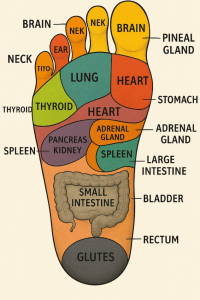The Power of Foot Massage: Why Applying Oil to Your Soles Can Support Your Whole Body
In a world increasingly driven by technology, stress, and constant movement, the search for simple, natural ways to support health and wellness is more relevant than ever. Among the ancient practices regaining attention is the humble yet profound act of foot massage—particularly when combined with the application of natural oils. Far from being just a luxury or indulgence, oil massage on the soles of the feet is deeply rooted in traditions like Ayurveda, Traditional Chinese Medicine (TCM), and reflexology. Scientific and anecdotal evidence alike suggest this ritual can yield remarkable benefits for the entire body—from improving sleep to boosting immunity and balancing the nervous system.
The Sole Connection: Why the Feet Matter
Your feet carry you through your day, absorbing the shock of every step and bearing the full weight of your body. Yet, they often receive the least attention in our wellness routines. But here’s a compelling reason to reconsider that: each foot contains over 7,000 nerve endings, as well as numerous pressure points that correspond to different organs and systems within the body.
According to reflexology, a healing practice that dates back to ancient Egypt and China, the feet serve as a microcosm of the entire body. Each area of the sole corresponds to a different part of the anatomy. Stimulating these areas through massage and the application of oil can activate energy pathways and promote healing throughout the entire system.
Ancient Wisdom: Ayurveda and Padabhyanga
In Ayurveda, the traditional medicine system of India, foot massage with oil is known as Padabhyanga. It is considered one of the most grounding and healing practices for restoring balance and vitality. Ayurvedic practitioners often recommend daily or weekly foot massages using warm, dosha-specific oils like sesame, coconut, or ghee to improve circulation, detoxify tissues, and pacify the nervous system.
Padabhyanga is said to:
-
Calm the vata dosha, which governs movement and is responsible for anxiety, insomnia, and restlessness.
-
Improve digestion and elimination by activating pressure points.
-
Enhance vision and eye health.
-
Nourish the skin and soften cracked heels.
-
Induce deep relaxation and help with mental clarity.
The Science of Sole-Soothing Oils
While traditional knowledge offers a powerful foundation, modern science provides further insight into why oil foot massage is effective.
-
Improved Circulation: The soles of your feet are farthest from your heart, making them susceptible to poor blood flow—especially as we age or sit for long periods. Massaging them encourages better circulation, delivering oxygen and nutrients throughout the body.
-
Nervous System Activation: The feet are densely packed with nerve endings, and gentle stimulation can activate the parasympathetic nervous system, which is responsible for rest, repair, and digestion. This means that rubbing oil into the feet can help shift the body from a state of stress (fight or flight) into a state of calm.
-
Enhanced Absorption: The skin on the soles of the feet is uniquely permeable. When oils are applied here, they are often absorbed more efficiently than in other parts of the body, allowing their therapeutic compounds to enter the bloodstream quickly. This is especially true for essential oils like lavender, peppermint, or eucalyptus, which can deliver benefits such as anti-inflammation, relaxation, or immune support.
-
Improved Sleep: Numerous studies and anecdotal reports suggest that massaging the feet with oils like castor oil, almond oil, or lavender essential oil before bed can significantly improve sleep quality. This is partly due to the stimulation of certain reflexology points tied to the brain and pineal gland, which governs the sleep-wake cycle.
-
Hormonal Balance: Some evidence suggests that reflexology and foot massage may help regulate hormones by targeting glands through specific foot zones, particularly the pituitary, thyroid, and adrenal glands. This may explain why many women find foot massages helpful during menstruation or menopause.
The Best Oils for Foot Massage
Choosing the right oil depends on your specific needs and constitution. Here are a few popular options:
-
Sesame Oil: Warming and grounding; best for cold feet or vata imbalance.
-
Coconut Oil: Cooling and anti-inflammatory; ideal for hot climates or pitta imbalance.
-
Mustard Oil: Stimulating and warming; often used in colder weather to improve circulation.
-
Castor Oil: Rich and deeply penetrating; good for pain relief and detoxification.
-
Almond Oil: Light and nourishing; great for dry skin and nervous system support.
-
Olive Oil: Moisturizing and anti-inflammatory; widely available and good for most skin types.
-
Essential Oils (diluted): Lavender for sleep, peppermint for soreness, eucalyptus for congestion, and frankincense for spiritual grounding.
How to Perform a Healing Foot Massage with Oil
-
Warm the Oil: Place your chosen oil in a small bowl and warm it slightly—just enough to feel cozy but not hot.
-
Create a Calm Space: Sit somewhere quiet and comfortable. Consider adding relaxing music, soft lighting, or incense.
-
Massage Mindfully:
-
Start at the heel and work your way up to the toes.
-
Use your thumbs to make circular motions, kneading the arch and ball of the foot.
-
Apply gentle pressure to reflex points or tender areas.
-
Pay extra attention to the center of the foot and the big toe (linked to the head and brain).
-
Don’t forget the ankles and the Achilles tendon.
-
-
Use Socks or Rest: After the massage, slip on cotton socks to retain warmth and allow the oil to penetrate overnight. Or simply lie down and rest for a few minutes.
When and How Often?
-
For general well-being, 2–3 times a week can be sufficient.
-
For insomnia, stress, or hormonal issues, nightly massages may be more beneficial.
-
Athletes or people on their feet all day may find daily practice enhances recovery.
Who Should Avoid It?
While foot massage is generally safe, avoid it if:
-
You have open wounds, skin infections, or severe varicose veins.
-
You’re in the first trimester of pregnancy (unless guided by a professional).
-
You’re using essential oils without proper dilution.
The Bigger Picture: More Than Just Feet
A consistent foot oil massage practice isn’t just about pampering yourself. It’s an intentional act of self-care that ripples through the body. It signals to your brain and nervous system: “I am safe. I am grounded. I am cared for.”
Whether you’re seeking better sleep, less anxiety, improved digestion, or simply a moment of peace, this ancient and affordable ritual offers a gateway to profound healing. By connecting with the soles of your feet, you reconnect with the entirety of your body—and perhaps even with a deeper part of yourself.
So tonight, before slipping under the covers, pause for a few quiet minutes, warm some oil, and give your feet the love they deserve. Your whole body—and mind—just might thank you.


